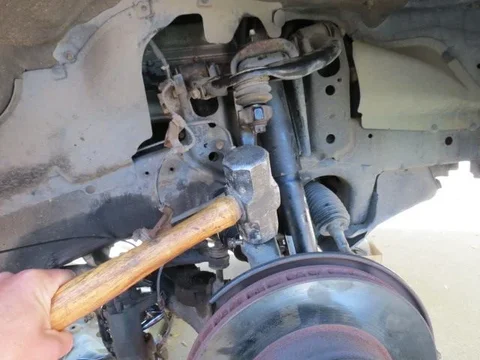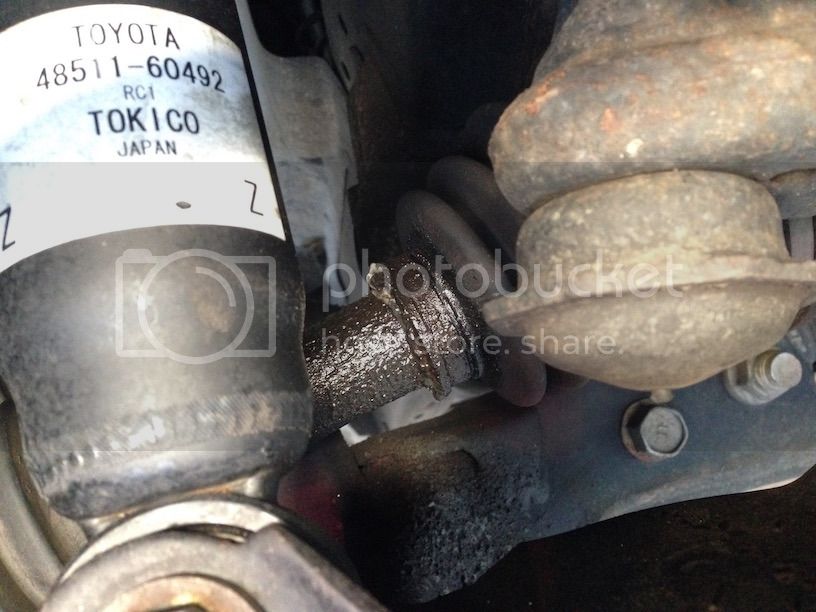A few weekends ago I replaced my CV boots on my 99 LX470 which had one split and the other one was leaking. I chose not to disassemble the hubs because vehicle only has 56K. Reboot kits were purchased from Dan at American Toyota for about 30 bucks/side. For reference I used the 2004 FSM that I found here:
https://forum.ih8mud.com/100-series-cruisers/375561-pdf-download-lc.html (pages SA-25 through SA-36 found under “Suspension and Axle”)
1. Jack up one side of the vehicle. Remove tire. Keep the side you are working on at least 4” higher to keep from losing differential fluid after pulling axle.
2. Remove the hub dust cap by tapping the seam with a very sharp screwdriver or scraper blade.
3. Remove the outer axle snap ring. New one not included in kit.
4. Remove the ABS sensor and harness (3 screws; 2 are 12m and a 10m holds it in place).
5. Remove the brake caliper (2 bolts) and hang it up out of the way with zip ties.
6. Remove the upper ball joint with a pitman arm puller. This usually creates a loud pop when separated.
7. Go underneath and use 2 pry bars to work the inboard joint assembly out of the differential. Be careful not to bend the dust covers. If you do just straighten them prior to assembly.
8. Pull inboard joint assembly out of differential. Now pull outboard joint out of hub.
9. *In order to clear the shock mount and the stabilizer mount I turned the steering wheel to align the outboard boot with maximum clearance between the two.
10. Cut bands off the boots with a 3” air powered cutting disc or tin snips.
11. Place the inboard joint over a small pan to catch grease and cut the boot length-wise with a sharp knife or large scissors.
12. *Remove inner tulip ring next to the balls and cage. (Very important)
13. Now the inboard balls and cage will slide out of the tulip. No need to use a BFH. Note cage direction before removal and marking of matchmarks using a paint pen (see FSM).
14. Remove the inner snap ring that holds the inner race on the shaft.
15. Remove the inner race by striking it with a brass hammer sliding it off the axle end.
16. Clean balls, cage and parts with brake cleaner. *Be careful while cleaning the cage it is extremely sharp and will cut your fingers.
14. Place outboard joint over a pan and cut and remove the boot.
15. *Outboard joint does not come apart. Clean with a can of brake fluid.
16. Position outboard joint and axle shaft vertically to fill with CV grease (larger tube).
17. Tape axle splines with electrical tape to protect boot installation. Install boot. *I chose to use 3/16” smooth band worm-drive hose clamps found here:
McMaster-Carr
part #5574K25 4” to 4-3/4” and part #5574K16 1” to 1-5/8”
18. Slide inboard boot over shaft, then cage, note cage direction (smaller end goes first).
19. Remove tape and install inner race with brass hammer and install new snap ring.
20. Reassemble cage with balls while installing it in tulip or use CV grease to hold balls in place. Install new inner ring.
21. Fill assembly vertically with smaller tube CV grease and install boot with clamps.
22. Remove old and install new axle snap ring on the end of axle. Apply grease to snap ring in order to position it with the opening towards the bottom.
23. Insert axle into differential and apply pressure on the inboard tulip until in “locks” in. Look underneath at other axle to insure that full insertion is achieved. Try pulling it out to make sure it is locked in. Driver’s side went in easy. *Passenger side was a 1 ½ hour project which I couldn’t get it to lock in until I ended up tapping a 3’ 2”x2” with a towel on the boot end to lock it in.
24. Insert the outboard joint into the hub. Prior to I added some wheel bearing grease into exposed hub bearing and used a needle tip to insert grease into upper ball joint bottom boot opening.
25. *Pull the upper and lower arms together to set the ball joint by using a small ratchet strap. Torque the ball joint nut to 81 ft lbs. Install cotter pin. Install outer axle snap ring and dust cap.
26. Install brake caliper, abs sensor and tire/wheel.
27. 2 hours later, one side complete, now perform the same on the other.
(*) indicates helpful hints I learned.
1st pic is the Pitman arm puller on the upper ball joint.
2nd pic is the important inboard inner tulip ring removed in order to remove the cage and balls.
Last pic is installed with smooth band hose clamps.
More pics available.
View attachment 423872View attachment 423873View attachment 423874






